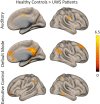Auditory Stimulation Modulates Resting-State Functional Connectivity in Unresponsive Wakefulness Syndrome Patients
- PMID: 33664643
- PMCID: PMC7921457
- DOI: 10.3389/fnins.2021.554194
Auditory Stimulation Modulates Resting-State Functional Connectivity in Unresponsive Wakefulness Syndrome Patients
Abstract
Passive listening to music is associated with several psychological and physical benefits in both, healthy and diseased populations. In this fMRI study, we examined whether preferred music has effects on the functional connectivity within resting-state networks related to consciousness. Thirteen patients in unresponsive wakefulness syndrome (UWS) and 18 healthy controls (HC) were enrolled. Both groups were exposed to different auditory stimulation (scanner noise, preferred music, and aversive auditory stimulation). Functional connectivity was analyzed using a seed-based approach. In HC, no differences were found between the three conditions, indicating that their networks are already working at high level. UWS patients showed impaired functional connectivity within all resting-state networks. In addition, functional connectivity of the auditory network was modulated by preferred music and aversive auditory stimulation. Hence, both conditions have the potential to modulate brain activity of UWS patients.
Keywords: auditory stimulation; disorders of consciousness; neurological early rehabilitation; resting-state fMRI; unresponsive wakefulness syndrome.
Copyright © 2021 Boltzmann, Schmidt, Gutenbrunner, Krauss, Stangel, Höglinger, Wallesch, Münte and Rollnik.
Conflict of interest statement
The authors declare that the research was conducted in the absence of any commercial or financial relationships that could be construed as a potential conflict of interest.
Figures




References
LinkOut - more resources
Full Text Sources
Other Literature Sources

